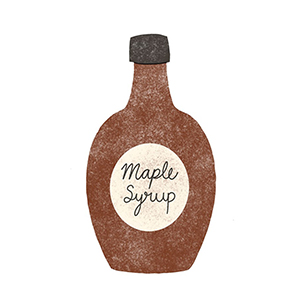
Illustrations: Jamie Klang
The beloved Woodbury Farmers Market features locally grown products.
Bustling with fresh produce, local honey, beautiful flowers and more, the Woodbury location of the Saint Paul Farmers’ Market—which hosts several markets in the Metro—is the place to be on Sunday mornings during the summer months and into fall.
From the beginning of June to the end of October, the popular market runs from 8 a.m. to 1 p.m., in the Central Park parking lot in Woodbury. After a long winter, the return of the market is much anticipated
by loyal customers. In fact, the support of the market from the Woodbury community is so strong, it makes it one of the most popular markets that the organization operates.
“It’s very competitive to get in to be a vendor at the Woodbury market,” says Ben Bicknese, executive assistant for the Saint Paul Farmers’ Market. “During the peak of the season, we have about 40 vendors there. It’s very successful, and the community responds well. And it’s a great location by the YMCA with a lot of parking. The Woodbury market is extremely accessible.”
Fresh and Vibrant
 The Woodbury Farmers Market, a branch of the Saint Paul Farmers’ Market, is one of 18 markets located in five counties operated by the Saint Paul Growers Association Inc. What’s unique about the organization, compared to other markets, is only fresh, locally grown produce can be sold.
The Woodbury Farmers Market, a branch of the Saint Paul Farmers’ Market, is one of 18 markets located in five counties operated by the Saint Paul Growers Association Inc. What’s unique about the organization, compared to other markets, is only fresh, locally grown produce can be sold.
“It has to be agriculturally based,” Bicknese says of what is offered at the market. “This is a big part of our identity and culture—it’s all about food.”
Bicknese highlights fresh produce multiple times, but also says vendors sell bagel sandwiches, baked goods, beef, cheese, eggs, herbs, honey, lamb, maple syrup, organic plants, flowers, plants and shrubs, pork, poultry, and many other items.
“What is also neat is the products change with the season,” he says, noting sweet corn season is popular. “It can be a brand new market week-to-week.”
When community members visit the farmers market, Bicknese says the experience offers something a grocery store can’t.
 “Obviously, people need food, and they need to get it from somewhere,” he says. “But going to the grocery store is a mechanical transaction. Going to the farmers market is such a different experience.”
“Obviously, people need food, and they need to get it from somewhere,” he says. “But going to the grocery store is a mechanical transaction. Going to the farmers market is such a different experience.”
At the market, consumers can speak directly with the person who grew the food they are buying. They’re able to ask about how it was grown, what variety it is, what worked and what didn’t.
“They find out so much more about the food they’re eating,” Bicknese says. “It’s so rewarding to see that type of interaction.”
Aside from gaining knowledge about the food that will fuel the body, it also brings people together. At the market, he sees families visiting and creating their own little community.
“We have a large crowd that comes to the market after church,” he says. “It just adds to the vibrant, busy market that Woodbury is.”
A Welcoming Community
 Another characteristic of the Woodbury Farmers Market is the Hmong farmers, who provide a strong anchor to Minnesota’s farming community.
Another characteristic of the Woodbury Farmers Market is the Hmong farmers, who provide a strong anchor to Minnesota’s farming community.
“A large percentage of our vendors are from the Hmong community,” Bicknese says. “It’s a really great story.”
After aiding the United States during the Vietnam War, many Hmong families immigrated to Minnesota, Bicknese says. Behind California, Minnesota is home to the largest Hmong population in the U.S. The talented, hard-working farmers are a staple to the Woodbury market, Bicknese adds.
“Hmong people taught themselves how to grow vegetables for a farmers market, and it’s become an amazing success story,” he says. “It’s an important part of our identity.”
Access for All
With the intention to cater to everyone, the Woodbury market accepts EBT cards. Bicknese says it’s important to note that Saint Paul Growers Association Inc. aims to hit all demographics.
“We’re all inclusive for everyone, and that’s what we want to be,” he says. “Everyone is welcome to our markets. We want to do our best to serve our community and get them healthy food.”
While many vendors will accept credit card transactions, the market has a token system. Credit cards can purchase $5 tokens to be used at the market. “We just run your credit card, and we give you the tokens,” Bicknese says. “All the vendors accept them.”
Giving back
Bicknese says last year, a pilot program started in partnership with North Country Food Alliance, a food recovery program, using grant funding.
In 2022, the program purchased 35,000 pounds of waste-diverted food from market vendors and brought it to a local food shelf. Vendors received $1 for every pound purchased. “That means $35,000 went back into our vendors’ pockets,” Bicknese says. “This money goes right back to a small business owner or farmer. It’s pretty amazing.”
A Long History of the St. Paul Market
The history of the Saint Paul Farmers’ Market is long and interesting. The market started before Minnesota was officially a state; as early as 1852, the Minnesota Pioneer newspaper called for a farmers market. So, St. Paul’s first public market, a two-story brick building, was constructed at Seventh and Wabasha streets. Fresh produce was available while it was in season, but dairy products, flour, cakes and candies could be purchased year-round
Although the St. Paul market has had several homes over the years, it has always remained in downtown St. Paul. In 1902, it opened at 10th and Jackson streets and remained there until freeway construction and development claimed the site. It then moved to Fifth and Wall streets in 1982. Its current location is near one of the areas selected in 1853 to house the original market.
Woodbury Farmers Market
8595 Central Park Place; 651.227.8101
Facebook: St Paul Farmers Market
Instagram: @stpaulfarmersmarket






















